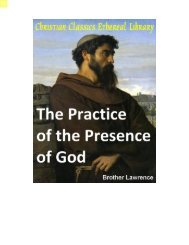Faith, Form and Light: A Guide to the Stained Glass Windows at Christ Anglican Church
Grace Converse, PhD Candidate in Art History at USC offers descriptions of the artistic elements and symbolic meanings of the stained glass windows at Christ Anglican Church, Carefree, Arizona
Grace Converse, PhD Candidate in Art History at USC offers descriptions of the artistic elements and symbolic meanings of the stained glass windows at Christ Anglican Church, Carefree, Arizona
You also want an ePaper? Increase the reach of your titles
YUMPU automatically turns print PDFs into web optimized ePapers that Google loves.
<strong>Christ</strong> <strong>Anglican</strong> <strong>Church</strong>, <strong>Stained</strong> <strong>Glass</strong> <strong>Windows</strong><br />
Introduction<br />
The ten stained glass windows in this series are situ<strong>at</strong>ed along <strong>the</strong> south <strong>and</strong> north faces of <strong>the</strong> church’s<br />
cleres<strong>to</strong>ry above <strong>the</strong> nave. The windows proceed clockwise beginning with <strong>the</strong> sou<strong>the</strong>ast window. Each<br />
window has <strong>the</strong> same dimensions—approxim<strong>at</strong>ely 2 ft wide by 3 ft tall—<strong>and</strong> are each <strong>the</strong> same height<br />
from <strong>the</strong> ground (18 ft). The uniform size <strong>and</strong> elev<strong>at</strong>ion cre<strong>at</strong>e continuity in <strong>the</strong> series. This continuity,<br />
in turn, is fur<strong>the</strong>r aided by several repetitions of forms appearing across <strong>the</strong> series of windows.<br />
First is <strong>the</strong> repetition of a thick, red external border of uniform width on each side, <strong>and</strong> a slender white<br />
inner rectangular border, which <strong>to</strong>ge<strong>the</strong>r frame each window’s central image. The second form which<br />
appears throughout is <strong>the</strong> vertical, cyan stripe. This bright blue b<strong>and</strong> is comprised of two thin vertical<br />
panes of equal width, such th<strong>at</strong> <strong>the</strong> central black b<strong>and</strong> th<strong>at</strong> connects <strong>the</strong>m perfectly bifurc<strong>at</strong>es <strong>the</strong> left<br />
half of <strong>the</strong> image from <strong>the</strong> right. This blue stripe runs from <strong>the</strong> <strong>to</strong>p <strong>to</strong> bot<strong>to</strong>m in each window,<br />
intersecting <strong>the</strong> red <strong>and</strong> white frame.<br />
This placement cre<strong>at</strong>es depth in <strong>the</strong> compositions as we inn<strong>at</strong>ely underst<strong>and</strong> or assume th<strong>at</strong> <strong>the</strong> blue<br />
exists in front of <strong>the</strong> red <strong>and</strong> white border. The main symbolic <strong>and</strong> gur<strong>at</strong>ive components of each<br />
window appear <strong>to</strong> rest or hang on <strong>the</strong> blue b<strong>and</strong> as if it is a pilaster, column, or beam. This lends<br />
additional signicance <strong>to</strong> <strong>the</strong> central fe<strong>at</strong>ures as <strong>the</strong>y are, or appear <strong>to</strong> be, elev<strong>at</strong>ed out of <strong>and</strong> above <strong>the</strong><br />
red <strong>and</strong> white surrounding elds. The consistent presence of <strong>the</strong> red, white, <strong>and</strong> blue forms also helps<br />
integr<strong>at</strong>e <strong>the</strong> windows in<strong>to</strong> <strong>the</strong> surrounding architecture of <strong>the</strong> building. Just as each cleres<strong>to</strong>ry<br />
window opening is <strong>the</strong> same size <strong>and</strong> is positioned <strong>at</strong> <strong>the</strong> same height, each image contains <strong>the</strong> same<br />
essential fe<strong>at</strong>ures. To th<strong>at</strong> end, <strong>the</strong> border area <strong>and</strong> b<strong>and</strong> of blue in each window oper<strong>at</strong>e both<br />
metaphorically <strong>and</strong> concretely as a transitional zone between <strong>the</strong> m<strong>at</strong>erial realm of <strong>the</strong> church wall <strong>and</strong><br />
<strong>the</strong> spiritual world represented in each central image.<br />
These repe<strong>at</strong>ed forms fur<strong>the</strong>r parallel <strong>the</strong> function of <strong>the</strong> church’s architecture: <strong>the</strong>y provide a<br />
consistent ground <strong>to</strong> support a multitude of colors, shapes, symbols, <strong>and</strong> gures just as <strong>the</strong> physical,<br />
built environment of this church provides a steady space for its many parishioners throughout <strong>the</strong>ir<br />
lives <strong>and</strong> <strong>the</strong> vari<strong>at</strong>ions in <strong>the</strong>ir journeys of faith. While one’s experience in this church is sacred, it is<br />
not conned <strong>to</strong> this physical building. We are reminded of this in viewing <strong>the</strong> aspects of select<br />
windows th<strong>at</strong> are not contained by <strong>the</strong> red <strong>and</strong> white frame. These fe<strong>at</strong>ures cross through <strong>the</strong><br />
composition’s boundary <strong>to</strong> reach <strong>the</strong> edges of <strong>the</strong> composition.<br />
Ultim<strong>at</strong>ely, this movement, expansion, <strong>and</strong> transform<strong>at</strong>ion—both of <strong>the</strong> compositional elements <strong>and</strong> in<br />
our daily lives—is <strong>the</strong> essence of why stained glass is powerful: it embodies <strong>the</strong> ability for an<br />
imm<strong>at</strong>erial, intangible entity <strong>to</strong> move through a m<strong>at</strong>erial form, <strong>at</strong> once transforming <strong>and</strong> causing<br />
transform<strong>at</strong>ion. The small clear, diamond-shaped panes th<strong>at</strong> appear in each window most acutely<br />
represent this phenomenon as <strong>the</strong>y refract light through colorless glass <strong>to</strong> reveal a full spectrum of<br />
colors. In doing so, <strong>the</strong>se diamonds provide a reminder th<strong>at</strong> this phenomenal interaction of <strong>the</strong> physical<br />
<strong>and</strong> imm<strong>at</strong>erial, of spirit <strong>and</strong> m<strong>at</strong>ter, is as miraculous as it is profoundly simple, universal, <strong>and</strong> everpresent.<br />
The artist Chris Powers of Scottsdale, Arizona cre<strong>at</strong>ed this series of ten stained glass windows. Powers<br />
conceived of <strong>the</strong> imagery <strong>and</strong> was assisted by <strong>the</strong> utiliz<strong>at</strong>ion of extant designs <strong>and</strong> collabor<strong>at</strong>ive<br />
convers<strong>at</strong>ions with <strong>the</strong> Rev. Canon Steven E. Dart. The Rt. Rev. John Upham blessed <strong>the</strong> windows on<br />
<strong>the</strong> twentieth anniversary of <strong>the</strong> consecr<strong>at</strong>ion of <strong>Christ</strong> <strong>Anglican</strong> <strong>Church</strong> on November 24, 2019.






